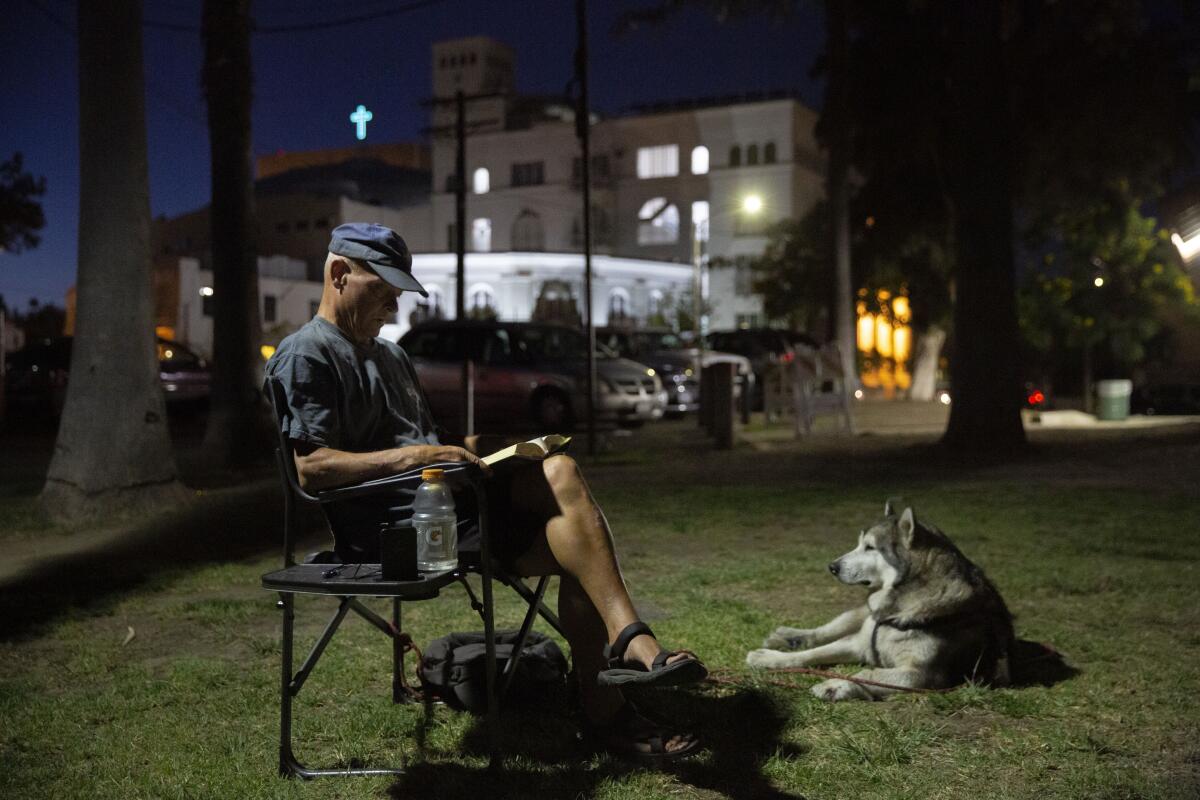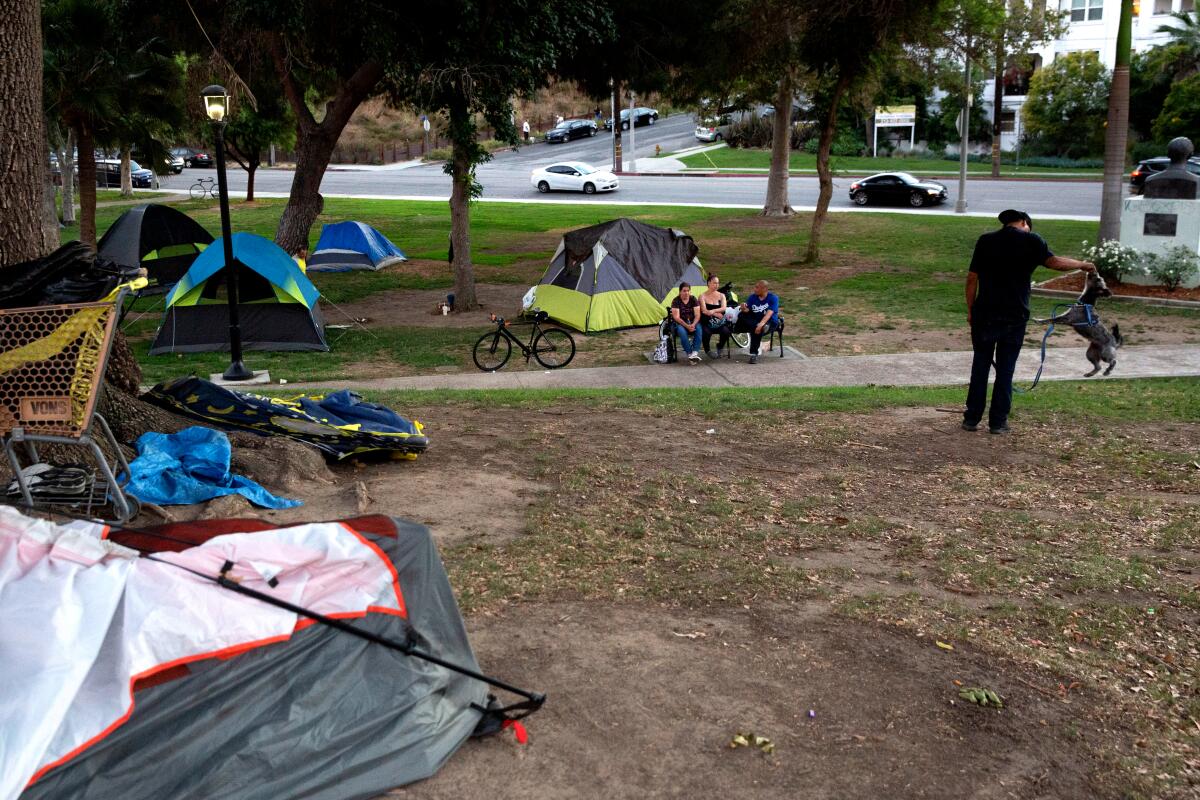Column: Would forcing homeless people to move inside and off the streets work?

Steve Saad, who has camped out in the Sepulveda Basin for eight years, had to find a new place to sleep last week after fire raged through his campsite. I asked if he’d prefer living in a shelter to being homeless, if a bed were available, and he said no. Some of those places have too many rules about coming and going, he said, and some of them separate couples.
In downtown Los Angeles, a man who lives in a tent pitched near the 101 Freeway agreed with that assessment. There was no way he’d move into a shelter, said the man, who identified himself only as Harvey. They’re full of disease, and he feels safer in a tent, he said.
For the record:
12:54 p.m. Aug. 3, 2019An earlier version of this column incorrectly referred to Kris Freed of Los Angeles Family Housing as Kim Freed.
At Echo Park Lake, military veteran Shane Isaacson said it was an interesting idea, but he would rather continue living in his Jeep with his dog, Bear, than move into a shelter.

Only one homeless person I talked to in my informal survey, David Parcher, who also lives in the park, saw it differently. Yes, he said, he’d take the shelter bed, even though he understood why so many other homeless people might not.
“Some of us don’t always do what’s in our own best interest,” Parcher said.
I was asking the question because new ideas are not abundant in the world of homelessness policy, but two California politicians have come up with something that’s a little different and a lot controversial.
Los Angeles County Supervisor Mark Ridley-Thomas and Sacramento Mayor Darrell Steinberg, both involved in homeless issues for years, have proposed a new approach, in which the state would establish a right to shelter and make sure there’s a bed for every homeless person now camped on streets, riverbeds and parks.
This is a change in direction because for several years, the focus has been on building permanent supportive housing rather than temporary shelter. But the more radical part of the proposal is this:
Once beds were available, homeless people would be forced to move inside.
“The public policy of this state must be that people live indoors,” said Steinberg, who noted that the number of deaths among the homeless is rising — more than 900 last year in Los Angeles County alone. If we can get more people inside, he said, it would be much easier to help people get well and find long-term solutions to their problems.
“Imagine what our communities would look and feel like if people had both a right to come inside and an obligation to come inside,” Steinberg said. “It’s common sense. You’d enforce it by telling people they can’t camp, and removing the campsite, and escorting people indoors.”

The idea is conceptual at the moment, with no details on how to pay for the shelters or how to make people come inside if they don’t want to. But it comes out of a frustration that, despite spending hundreds of millions of dollars to bring homelessness numbers down, they’re going up statewide.
“You just happen to be talking to two guys who have lifted heavily on homelessness,” said Ridley-Thomas, noting that he pushed for the homeless services made possible under L.A. County’s Measure H. Steinberg, a former state senator, was the godfather of the Mental Health Services Act, which has generated billions of dollars in services.
“I believe we have to have multiple strategies … to lick this problem,” Ridley-Thomas said. “It is kicking our asses. All right? It just is.”
In an op-ed for The Times, Steinberg gave a nod to New York City, saying that 90,000 people will be housed in motels, hotels and apartments there in 2019 under a consent decree requiring the city to provide shelter to everyone, and that the city has managed to get most of its homeless population off the streets.
But the idea is already drawing fire in Los Angeles, where some advocates for the homeless consider sheltering and warehousing too similar, and they fear the California shelter idea would drain money from permanent housing and other resources without providing long-term solutions. Kris Freed of Los Angeles Family Housing said her nonprofit could use a few more shelter beds, but she doesn’t see that as the right focus.
“The cost is so high to keep people housed in shelters that there won’t be enough money on the back end” for permanent housing, Freed said. “I understand the frustration from the public … and we get calls every day from homeowners where encampments are. But we’re moving people into housing faster than ever.”
Tommy Newman of United Way Los Angeles said a right to housing, not shelter, might make more sense. And he’d rather see the “statewide collective brainpower” focus on building that housing faster by scaling back environmental restrictions, regulatory requirements and land-use permits. In L.A. County, it can take two or three years to approve and build a single unit.
Even if you were to build the shelters, Newman said, “we’d be left with a monumentally complicated conversation about how to force people indoors.”
That’s a fair point, and one I’ve wrestled with on a personal level. Nearly 15 years ago, I tried to help Nathaniel Anthony Ayers, a man with schizophrenia, move into supportive housing. He resisted with every fiber of his being, and under California law, he couldn’t be forced off the streets. It took a year, and a lot of hard work by several professionals, to earn his trust and get him to agree to housing, and it hasn’t been a smooth road since then.
Back when I was first trying to get help for Nathaniel, one of the people who told me we should be cautious about forcing people in against their will was Steinberg. I had sought his counsel because he’d worked so hard to help the thousands of homeless people suffering from mental illness. Let’s get services in place, Steinberg argued, before we challenge people’s civil rights.
Steinberg told me last week that his thinking has evolved somewhat in the years since then, as the homeless population has exploded. As mayor of Sacramento, which has a large homeless population, the pressure to find solutions hits him more directly now than it did when he was a state senator.
But he and Ridley-Thomas told me they are no less committed to supportive housing or to addressing homelessness prevention and the economic forces that keep pushing more people out of their homes. They said they view more shelters not as the answer but as a first step to long-term recovery for those who would otherwise be on the street for years while we build needed housing. Steinberg added that he believed most people would come indoors if they had the chance.
And if someone resists?
“I don’t think you arrest people,” Steinberg said, adding that some form of conservatorship might be a tool for getting someone to take advantage of an opportunity to improve their lives. “I just believe, and I think Californians believe, that living outdoors for a long period of time is by definition unhealthy. It shortens your life, and it puts you at risk of being a victim of violent crime or sexual assault.”
We’re probably a long way from the shelter idea being put into practice. Steinberg and Ridley-Thomas said they’ll look at executive, legislative and legal ways to move forward.
I don’t know if theirs is the best idea, but I do know this: California is in the midst of an epic human crisis years in the making, and we need new ideas for addressing it. So long as we don’t shortchange existing programs that work, it’s worth exploring this and other ways to step up the response.
More to Read
Sign up for Essential California
The most important California stories and recommendations in your inbox every morning.
You may occasionally receive promotional content from the Los Angeles Times.











